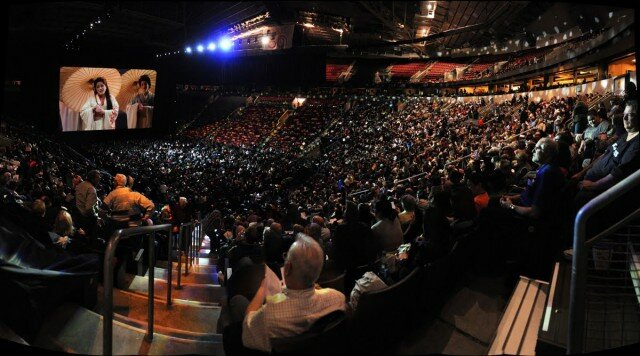
On Saturday night, seats at Seattle Opera‘s McCaw Hall filled with opera-goers eagerly anticipating the opening night performance of Puccini’s Madama Butterfly. Meanwhile, on the other side of the Seattle Center campus, 5,000 [5,126 to be precise–ed.] fans streamed into KeyArena to experience the same event, broadcast live in HD.
Saturday’s simulcast is part of a nationwide spate of outreach efforts seeking to bring opera to a wider audience. San Francisco Opera, Washington National Opera, and Dallas Opera have hosted similar events, drawing crowds as large as 16,000.
The combination of world-class singing, high-tech wizardry, and free tickets seems to be winning over an opera-curious public, attracting those who might not otherwise attend a live opera performance. Public response to Saturday’s simulcast has been overwhelmingly positive. Will simulcasts catch on and become a mainstay of the opera world? Is the simulcast experience even worthwhile, or is it better to catch the show at the opera house?
Three friends and I attended last night’s simulcast with these questions in mind. All four of us have seen operas at McCaw Hall in the past and were unsure if the simulcast experience would compare. (Another friend decided not to come along because the idea of watching an opera on a screen was not as appealing as seeing it “in real life”).
Although nothing can replace the experience of attending a live production in an opera house, watching a broadcast of the show in a cavernous sports arena has a unique appeal of its own. Here are six reasons why Seattle Opera’s simulcast scored big in my book.
#1. You can leave the opera glasses at home.
When the screen is fifty feet tall, everyone in the audience feels like they’re sitting in the front row. It’s thrilling to get up close and personal with some of the world’s greatest operatic talents. The big screen view offers an opportunity to appreciate the singers’ acting skills and admire the gorgeous costumes and makeup. Though vital, these aspects of the performance aren’t always visible in the opera house, especially to those in the back rows. Subtle nuances in the facial expressions and body language of the singers added extra depth to Madama Butterfly‘s emotional intensity, something my friends and I would have missed had we been sitting in McCaw Hall’s nosebleed section.
#2. Crystal-clear audio and visuals.
The technical aspects of Saturday’s simulcast were nearly flawless. Live editing between multiple cameras ensured that the KeyArena audience always had the best view of the action, even offering a few glimpses into the orchestra pit. The sound quality was generally excellent as well.
#3. You get to sip and munch during your favorite arias.
How many opera houses allow audience members to drink alcohol during performances? Sure, booze is served during intermission, but what if you want to tip back a cold one while the Queen of the Night is hitting those impossibly high notes? Most opera simulcasts are held at sports arenas or ballparks, meaning that snacks and beverages are served during the entire event. So grab a bottomless tub of popcorn and enjoy the operatic action.
#4. Street clothes are the norm.
Granted, I sometimes wear jeans and a t-shirt to opera performances at McCaw Hall. Despite popular misconception, wearing jeans to the opera is perfectly acceptable here in Seattle. (In fact, the opera dress code is probably less strict than some expensive nightclubs). However, many people still choose to dress up when attending a performance at the opera house. At a simulcast, there’s no need to worry about what to wear. It’s in a sports arena, after all.
#5. It’s free.
Opera is plagued by a serious image problem. It’s stereotyped as elitist, exclusive, and snooty. In reality, the cost of attending an opera production is no more than a ticket to a sporting event, musical, or rock concert. Often, it’s not the ticket prices that give potential ticket-buyers pause — it’s their perception of opera that discourages them from giving it a try.
Free simulcasts open the world of opera to everyone, giving people from all walks of life the chance to experience this oft-misunderstood art form. They’re fantastic outreach events, providing an opportunity for opera companies to win thousands of fans in a single evening. Most importantly, they chip away at stereotypes.
Opera, like all art, should be accessible to everyone. It’s a lofty goal, perhaps far on the horizon, but events like simulcasts are helping us get there.